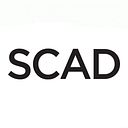Sanford Biggers’ deFINE keynote
“What is presented to you in an artwork is not the whole story,” said honoree Sanford Biggers during his keynote address at SCAD deFINE ART 2021. “There is a lot of code, and a lot of layers, to what you’re looking at.”
A 2020 Guggenheim Fellow, Biggers was speaking not of a specific piece, but of resonant works that have informed his own practice and world view, from “Rapper’s Delight” to the Venus de Milo to the quilts of Gee’s Bend. He was referring too to the work in his current solo exhibition Contra/Diction at the SCAD Museum of Art’s Walter O. Evans Center for African American Studies, the occasion for his deFINE presentation.
Biggers’ keynote was an artwork unto itself. He integrated aspects of his childhood in L.A., the subsequent mentorship of Spelman College’s Frank Toby Martin, and the patronage and friendship of collagist Varnette Honeywood into the hour-long talk. Delivered virtually in an open-to-the-public format, his keynote specifically addressed the concerns and interests of SCAD students. Biggers’ allyship was enhanced by the intimacy of the in-camera address.
“I started to consider myself an artist maybe even before high school, maybe junior high,” he said. “This was the early 80s, and I was a first-generation fan of Rap music. It was not hip-hop at that point. A cultural revolution was happening. As an early practitioner of the b-boy and b-girl arts, I found myself loving rap music, DJs, graffiti, and breakdancing. One of my earliest art experiences was sneaking out of my parents’ house and painting graffiti in the train yards of Los Angeles. This was pretty influential to the way I perceive art as not something one does in a vacuum or just in a studio, per se. It has performative elements, it has collaborative elements, and it has resonance beyond the galleries and museums where we typically show. I always strive to make art that can translate between those different contexts.”
Biggers discussed pieces from throughout his career, including ground-breaking works “LOTUS,” “OM II,” and “BLOSSOM.” He addressed Shinto singing bowls, melted-down boom boxes, and how art objects need to be not merely created but “activated.” He referred repeatedly to the formative experiences of his youth.
“In my high school AP class, I was assigned to paint portraits of the people around me,” he said. “The final day, I showed my oil paintings of Black people, my family and friends, and the white teacher held up my work and said, ‘Why do you always paint black people? Is this something political?’ I was 15. I thought it was a joke. Somehow painting my family and friends was a political statement? What we were considering normative was coming from one particular lens. Right there, I knew there was a polemic set up between my work and what my work was being perceived as. It had a profound effect.”
Biggers’ keynote culminated in a Q&A where he considered what students should do when they feel they have reached a limit in their art.
“Creativity presupposes output. If you’ve hit a wall, respect that and put it down for a while. You can overwork a muscle and at that point you’re destroying the muscle, and it’s time to work on other muscles. Creativity also has many different modes. Creativity is not always output. Sometimes creativity is intake. It can mean taking time off to read, or not to think about art. I guarantee if it’s in your bones, creativity will find a way out. You have to not be so hard on yourself sometimes. The creative process is an unwieldy beast — we can’t control it all the time.”
See Contra/Diction at SCAD MOA.
Written by Peter Relic
